Cartoon Brew attends DOK Leipzig to look at how a festival mixes together animation and documentary filmmaking.
The post Report: DOK Leipzig, A Festival That Mixes Animation and Documentary Films appeared first on Cartoon Brew.
Add a Comment
Cartoon Brew attends DOK Leipzig to look at how a festival mixes together animation and documentary filmmaking.
The post Report: DOK Leipzig, A Festival That Mixes Animation and Documentary Films appeared first on Cartoon Brew.
Add a Comment
Ireland's animators are getting the spotlight in a new documentary.
The post Exclusive Trailer: New Documentary About Irish Animation Industry appeared first on Cartoon Brew.
Add a Comment
Brad Bird, virtual reality, storyboarding, and true animation legends are part of our must-see Comic-Con events.
The post Comic-Con 2016: Five Must-See Animation Panels appeared first on Cartoon Brew.
Add a Comment
A behind-the-scenes look at the ultimate challenge: figuring out the story of "Zootopia."
The post WATCH: ‘Imagining Zootopia’ Is A Fantastic 47-Minute Look At The Making Of Disney’s Latest Film appeared first on Cartoon Brew.
Add a Comment
Designed for directors and producers from both animation and live-action documentary, AniDox:Lab expands storytelling possibilities by mixing the two schools of filmmaking.
The post Documentary Animators: Now Is The Time To Apply To Denmark’s AniDox:Lab appeared first on Cartoon Brew.
Add a Comment
Bob Hercules, Rita Coburn Whack, and their team of filmmakers hope to raise $150,000 on Kickstarter for a documentary profiling the late Maya Angelou. For this project, the collaborators have interviewed several people who knew Dr. Angelou including President Bill Clinton, media mogul Oprah Winfrey, and her son Guy Johnson. We’ve embedded a video about the new project above.
Here’s more from the Kickstarter page: “Dr. Angelou has become a global symbol of peace, humility, and freedom–– but parts of her story are not well known. The Maya Angelou Documentary will reflect on how the events of history, culture, and the arts shaped Dr. Angelou’s life and how she, in turn, helped shape our own worldview through her autobiographical literature and activism. We hope to shed light on the untold aspects of her life and to educate audiences about her story.”
Welcome to our Kickstarter Publishing Project of the Week, a feature exploring how authors and publishers are using the fundraising site to raise money for book projects. If you want to start your own project, check out How To Use Kickstarter to Fund Your Publishing Project.
Add a CommentThe new two-part Walt Disney documentary premieres tonight and tomorrow night. Share your thoughts on the film with the rest of the animation community.
Add a CommentGeorge Lucas's groundbreaking visual effects company is celebrated in a new one-hour special on the Science Channel
Add a CommentThe pioneering African-American animator is the subject of an in-depth exploration of his life and career.
Add a CommentEarly in our trip to Krakow we found ourselves seated beside an Irish couple at a restaurant. They'd returned that day from Auschwitz and Birkenau. They were insisting that we travel there as well. I was conflicted.
Today I am launching the website fallen.io <http://fallen.io> after many years in the making, and I would be so very delighted if you gave it a look.
http://www.fallen.io
The Fallen of World War II is a short animated data-driven documentary about war and peace. The film explores the harrowing statistics of World War II and sizes up its numbers to other wars in history, including recent conflicts. It's a dark portrayal of the war, but hang in there, because it's also very much a film about peace.
The documentary is unusual in the way it blends data visualization with filmmaking. It was created almost entirely with custom software so that the visuals could be closely choreographed with the underlying data. The sound design and original score were composed by my brilliant collaborator Andy Dollerson - so wear headphones! As a web-based film, it features interactive segments that allow viewers to pause and dig into the data visualizations that are rendered live on screen.
The media has a key role to play in the construction of our knowledge of crime and policing. In the post-war decades, they argue the representation of policing in the UK reflected the general social consensus. The dominant image here is Jack Warner playing George Dixon in the popular UK TV series Dixon of Dock Green that ran from 1955 to 1976. George Dixon came to represent the archetypal ‘British Bobby’, a pillar of the community who was widely respected. The homely and reassuring values that Dixon represented were summarized in his catchphrase ‘Evenin’ all’.
The post Watching the true detectives appeared first on OUPblog.
Kurt Cobain's life and art is brought to life by animation directors Hisko Hulsing and Stefan Nadelman.
Add a CommentEverything you wanted to know about the making of the Oscar-contending film "How to Train Your Dragon 2."
Add a Comment
One of the more interesting recent developments in film studies is the recognition that what has seemed to be separate histories — documentary filmmaking and avant-garde filmmaking — are, once again, converging. I say “once again” because the interplay between documentary and avant-garde film has long been more significant than seems generally understood.
An intersection of an avant-garde artistic practice and a documentary impulse helped to instigate the dawn of cinema itself. When Eadweard Muybridge and Etienne-Jules Marey were discovering and exploring the possibilities of photographic motion study, they were the photographic avant-garde of that moment. And their subject was the documentation of the motion of animals, birds, and human beings, presumably so that we could know, more fully, the truth about this motion. And at the moment when W. K. L. Dickson perfected the Kinetograph and Kinetoscope and the Lumière Brothers perfected the Cinématographe and the projected motion picture, they in turn became the photographic avant-garde; and their primary fascination, too, was the documentation of motion, specifically human activity, first, in the world around them and soon, in the case of the Lumières, across the globe.
Flaherty’s Nanook (1922) was both a breakthrough documentary and an avant-garde experiment in collaborative filmmaking; and the City Symphonies that emerged in the 1920s (Berlin: Symphony of a Big City, 1926, e.g., and The Man with a Movie Camera, 1929) were documentary interpretations of reality and avant-garde experiments.
During the 1940s, the most important development for independent cinema in the United States was the emergence of a full-fledged film society movement. The leading contributor was Cinema 16, founded by Amos and Marcia Vogel in New York City in 1947. At its height, Cinema 16 had 7,000 members, and filled a 1,500-seat auditorium twice a night for monthly screenings. Cinema 16’s programming was an inventive mixture of documentary and avant-garde film.
The development of light-weight cameras and tape recorders, more flexible microphones, and faster film stocks during the late 1950s created additional options that in one sense, drove documentary filmmaking and avant-garde filmmaking apart, but in another sense, created a different kind of intersection between them. Sync-sound shooting expanded the options available to filmmakers committed to documentary, instigating forms of cinematic entertainment that functioned as critiques of Hollywood filmmaking and early television. Drew Associates, D. A. Pennebaker, Frederick Wiseman, and the Maysles Brothers fashioned engaging melodrama out of real life in Crisis: Behind a Presidential Commitment (1963), Don’t Look Back (1967), Hospital (1968), and Salesman (1968).

During the same decade, avant-garde filmmakers were producing very different forms of documentary, often by abjuring sound altogether. Stan Brakhage was committed to the idea of cinema as a visual art, and created remarkable—silent—confrontations of visual taboo such as Window Water Baby Moving (1959) and The Act of Seeing with One’s Own Eyes (1972)—now recognized as canonical documentaries. These films could hardly have been more different from the cinema verite films, but we can now see that Brakhage shared the mission of the cinema verite documentarians: the cinematic confrontation of convention-bound commercial media.
In 1955, Francis Flaherty, Robert Flaherty’s widow, established a symposium to honor her husband’s filmmaking oeuvre and to promote his commitment to filmmaking “without preconceptions.” In recent decades “the Flaherty,” as the symposium has come to be called, has attracted dozens of filmmakers, programmers, teachers, students, and other cine-aficionados for week-long immersions in programs of screenings and discussions. Modern Flaherty seminars have often been driven by an implicit debate about what the correct balance between documentary and avant-garde film should be at the seminar.
Since the 1940s, avant-garde filmmakers have found ways of exploring the personal, first by psycho-dramatizing their inner disturbances (Maya Deren’s Meshes of the Afternoon and Kenneth Anger’s Fireworks are landmark instances), and later by filming the particulars of their personal lives. Brakhage documented dimensions of his personal life in many films, as did Carolee Schneemann, in Fuses (1967), and Jonas Mekas, in Walden (1969) and Lost Lost Lost (1976). And during the 1980s, avant-garde filmmakers Su Friedrich (in The Ties that Bind, 1984; and Sink or Swim, 1990) and Alan Berliner (in Intimate Stranger, 1991; and Nobody’s Business, 1996), used experimental techniques learned from other avant-garde filmmakers to directly engage their family histories.
What has come to be called “personal documentary” (basically, the use of sync-sound to explore personal issues) was instigated in the early 1970s by Ed Pincus’s Diaries (filmed from 1971-1976; completed in 1981), Miriam Weinstein’s Living with Peter (1973), Amalie Rothschild’s Nana, Mom and Me (1974), Alfred Guzzetti’s Family Portrait Sittings (1975). By the 1980s, several of Pincus’s students at MIT were contributing to this approach, among them Ross McElwee, whose films, including Sherman’s March (1986), Time Indefinite (1994), and Photographic Memory (2011) are an on-going personal saga.
Globalization and the standardization of so many dimensions of modern life, along with threats to the environment, have created a desire on the part of many filmmakers to pay a deeper attention to the particulars of Place. Since the early 1970s, contemplations of Place have been produced by avant-garde filmmakers Larry Gottheim (Fog Line, 1970; Horizons, 1973), Nathaniel Dorsky (Hours for Jerome, 1982), James Benning (13 Lakes, 2004), Peter Hutton (Landscape (for Manon), 1987; At Sea, 2007), Sharon Lockhart (Double Tide, 2009) and many others. A fascination with Place, or more precisely, people-in-place, also characterizes the documentaries coming out of Harvard’s Sensory Ethnography Lab (SEL), including Ilisa Barbash and Lucien Castaing-Taylor’s Sweetgrass (2009), Castaing-Taylor and Véréna Paravel’s Leviathan (2013), and Stephanie Spray and Pacho Velez’s Manakamana (2014). Indeed, the films of Hutton, Benning, and Lockhart, in particular, have been shown regularly at the SEL.
The interviewees in Avant-Doc reveal a wide range of ways in which their own work and the work of colleagues function creatively within the liminal zone between documentary and avant-garde and the ways in which the intersections between these histories have played into their work.
Headline image credit: Camera. Public domain via Pixabay.
The post Intersections of documentary and avant-garde filmmaking appeared first on OUPblog.
The anniversaries of conflicts seem to be more likely to capture the public’s attention than any other significant commemorations. When I first began researching the nurses of the First World War in 2004, I was vaguely aware of an increase in media attention: now, ten years on, as my third book leaves the press, I find myself astonished by the level of interest in the subject. The Centenary of the First World War is becoming a significant cultural event. This time, though, much of the attention is focussed on the role of women, and, in particular, of nurses. The recent publication of several nurses’ diaries has increased the public’s fascination for the subject. A number of television programmes have already been aired. Most of these trace journeys of discovery by celebrity presenters, and are, therefore, somewhat quirky – if not rather random – in their content. The BBC’s project, World War One at Home, has aired numerous stories. I have been involved in some of these – as I have, also, in local projects, such as the impressive recreation of the ‘Stamford Military Hospital’ at Dunham Massey Hall, Cheshire. Many local radio stories have brought to light the work of individuals whose extraordinary experiences and contributions would otherwise have remained hidden – women such as Kate Luard, sister-in-charge of a casualty clearing station during the Battle of Passchendaele; Margaret Maule, who nursed German prisoners-of-war in Dartford; and Elsie Knocker, a fully-trained nurse who established an aid post on the Belgian front lines. One radio story is particularly poignant: that of Clementina Addison, a British nurse, who served with the French Flag Nursing Corps – a unit of fully trained professionals working in French military field hospitals. Clementina cared for hundreds of wounded French ‘poilus’, and died of an unnamed infectious disease as a direct result of her work.
The BBC drama, The Crimson Field was just one of a number of television programmes designed to capture the interest of viewers. I was one of the historical advisers to the series. I came ‘on board’ quite late in the process, and discovered just how difficult it is to transform real, historical events into engaging drama. Most of my work took place in the safety of my own office, where I commented on scripts. But I did spend one highly memorable – and pretty terrifying – week in a field in Wiltshire working with the team producing the first two episodes. Providing ‘authentic background detail’, while, at the same time, creating atmosphere and constructing characters who are both credible and interesting is fraught with difficulty for producers and directors. Since its release this spring, The Crimson Field has become quite controversial, because whilst many people appear to have loved it, others complained vociferously about its lack of authentic detail. Of course, it is hard to reconcile the realities of history with the demands of popular drama.
I give talks about the nurses of the First World War, and often people come up to me to ask about The Crimson Field. Surprisingly often, their one objection is to the fact that the hospital and the nurses were ‘just too clean’. This makes me smile. In these days of contract-cleaners and hospital-acquired infection, we have forgotten the meticulous attention to detail the nurses of the past gave to the cleanliness of their wards. The depiction of cleanliness in the drama was, in fact one of its authentic details.
One of the events I remember most clearly about my work on set with The Crimson Field is the remarkable commitment of director, David Evans, and leading actor, Hermione Norris, in recreating a scene in which Matron Grace Carter enters a ward which is in chaos because a patient has become psychotic and is attacking a padre. The matron takes a sedative injection from a nurse, checks the medication and administers the drug with impeccable professionalism – and this all happens in the space of about three minutes. I remember the intensity of the discussions about how this scene would work, and how many times it was ‘shot’ on the day of filming. But I also remember with some chagrin how, the night after filming, I realised that the injection technique had not been performed entirely correctly. I had to tell David Evans that I had watched the whole sequence six times without noticing that a mistake had been made. Some historical adviser! The entire scene had to be re-filmed. The end result, though, is an impressive piece of hospital drama. Norris looks as though she has been giving intramuscular injections all her life. I shall never forget the professionalism of the director and actors on that set – nor their patience with the absent-minded-professor who was their adviser for the week.
In a centenary year, it can be difficult to distinguish between myths and realities. We all want to know the ‘facts’ or the ‘truths’ about the First World War, but we also want to hear good stories – and it is all the better if those elide facts and enhance the drama of events – because, as human beings, we want to be entertained as well. The important thing, for me, is to fully realise what it is we are commemorating: the significance of the contributions and the enormity of the sacrifices made by our ancestors. Being honest to their memories is the only thing that really matters –the thing that makes all centenary commemoration projects worthwhile.
Image credit: Ministry of Information First World War Collection, from Imperial War Museum Archive. IWM Non Commercial Licence via Wikimedia Commons.
The post The real story of allied nursing during the First World War appeared first on OUPblog.
When you think of countries that are known for their animation, Brazil is probably not among the first that comes to mind. However, the country has nearly a century-long history of producing animation, and while historically most of the animation they have made hasn't been seen outside of its borders, there have been notable contributions to the art form throughout the country’s history. With the animation industry growing quickly in Brazil—they are ranked seventh for countries that visit Cartoon Brew most often—it is a great time to explore the country's animation legacy.
Add a CommentThe 30-minute "Life After Pi" documents last year's financial collapse of vfx house Rhythm & Hues.
Add a Comment
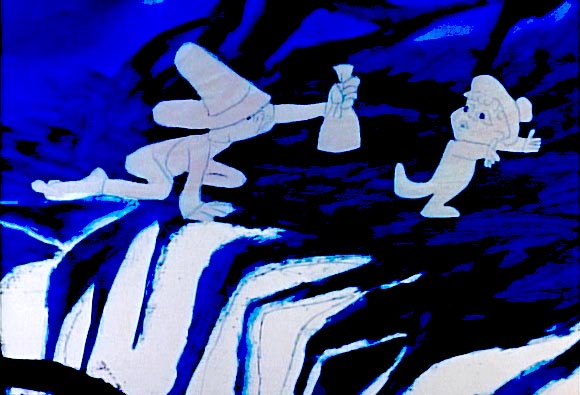
One of the better-known shorts made by John and Faith Hubley is Moonbird, from 1959. This film came about when the Hubleys made a secret recording of their two sons one night, playing a game in which they pretended to be hunting for the elusive Moonbird. The result was a soundtrack with a complete narrative, courtesy of the two children; the Hubleys and their studio then visualised the story to create the film.
It is surprising how well Moonbird works, considering that its story is simply two kids making things up as they go along. The personalities of the children come through very strongly and much of the recorded dialogue is inherently funny, as when the younger boy tries to recite “Hey Diddle Diddle” but has trouble remembering past the second word.

Moonbird was followed by the 1967 film Windy Day, based on the same concept but using the voices of the Hubleys’ two daughters. This short is much looser, with a transformative element as the two characters morph from one identity to another. Instead of a single narrative, the children deliver a free-flowing conversation which makes several twists: The two girls start by playing at being a knight and a princess, and later play at being animals; between these sessions they discuss birth, adulthood, marriage and death in the half-grasped manner of children.
Windy Day was shown at the 1968 Cambridge Animation Festival; amongst the people who saw it were producer Colin Thomas and animator William Mather.
“We were blown away by the use of raw unpolished sound with a highly controlled medium like animation”, said Mather in an interview I conducted with him in 2011. In 1975 the two put together a pilot film entitled Audition, based around a recording of Mather’s son talking to an organ player as he auditioned for the role of a choirboy.
The film is very different to Hubley’s shorts. Aside from a very brief sequence in which the boy imagines the organ turning into a monster, it does not take place in a world of childhood fantasy: Its aim is instead to recreate the conversation in more straightforward cartoon terms.
The Hubleys sought to create fantasy films when they made Moonbird and Windy Day, and turned to the taproot of so much fantasy: the imaginations of children. By contrast, Mather and Thomas created a film which was closer to documentary. It is worth noting that Thomas was a documentary filmmaker, and that BBC Bristol – the branch for which the two men made their pilot – has a strong documentary tradition.

The pilot led to Animated Conversations, a six-part series produced in the late-1970s by various directors. Mather contributed Hangovers, based on a recording of a barmaid and her customers, but the best-known shorts for this series were made by Aardman founders Peter Lord and David Sproxton.
The two Aardman shorts take quite different approaches. Down and Out is a literalistic portrayal of an elderly man being turned away from a hostel which – unlike Mather’s shorts – lacks any humor; its emphasis is instead on pathos. Confessions of a Foyer Girl, on the other hand, plays its material for laughs. A young cinema employee discussing the banal details of her day-to-day life is contrasted with the glamorous and exciting world of the movies.
Lord and Sproxton’s work on Animated Conversations prompted Channel 4 to commission its own series of animation based on natural dialogue, this time made entirely by Aardman: Late Edition, Sales Pitch, On Probation, Early Bird
and Palmy Day. As before, some of these went for wacky comedy, while others opted for melancholy tones.
Aardman’s subsequent work in this format includes Creature Comforts by Nick Park. As well as ranking as the single most famous example of the approach, it is one of the more playful in using its soundtrack. As the film is framed as a series of short interviews with various characters, Park was able to home in on the soundbites with the most comic potential. The earlier shorts built themselves around large chunks of undigested conversation, but the whole point of Creature Comforts is that the interviewees are quoted completely out of context.
Creature Comforts became an entire franchise, and in is now the key example of what is, today, a full-fledged genre of animation.
Sometimes the approach can serve a practical use. Animation students are often assigned the task of working to found soundtracks as lipsync exercises. “The Trouble with Love and Sex,” a 2011 episode of the BBC documentary series Wonderland, focused on people undergoing counselling; when it ran into the problem that these people were not comfortable being filmed, it simply used their voices, the visuals being animated by Jonathan Hodgson.
Meanwhile, other animators returned to the daring ethos of the Hubley shorts. Chris Landreth’s Ryan plays with intertextuality, using animation to illustrate interviews with and about animator Ryan Larkin. Sylvie Bringas and Orly Yadin’s’s Silence presents a child’s eye view of the Holocaust, alternating between harsh, woodblock-like sequences for the camp scenes and a softer, more childlike style for the postwar sequences.

There are three general approaches taken by these films. The first is a literalistic portrayal of the conversation, as with the melancholy Down and Out, the lighthearted Late Edition and the harrowing Waltz with Bashir (the last of these being the only feature-length animation of this type that I am aware of.) The second approach creates comedy by placing ordinary dialogue into an unusual situation, as with Creature Comforts.
Finally, the third approach uses animation to illustrate the more subjective aspects of the soundtrack, usually by attempting to recreate the mental state of the speaker. Examples include Silence, Ryan, Marjut Rimminen’s Some Protection, Paul Vester’s Abductees and Andy Glynne’s Animated Minds.
Jan Svankmajer once remarked that “animators tend to construct a closed world for themselves, like pigeon fanciers or rabbit breeders.” When an animated film uses unscripted audio, what we see is pure fantasy, but what we hear is an actual moment in time—the closed world of animation is suddenly opened up to stark reality.
IMAGES AND VIDEO IN THIS PIECE
1.) Still from Moonbird
2.) Still from Windy Day
3.) Audition
4.) Still from Confessions of a Foyer Girl
5.) Still from Creature Comforts
6.) Clip from “The Trouble with Love and Sex”
7.) Still from Waltz with Bashir
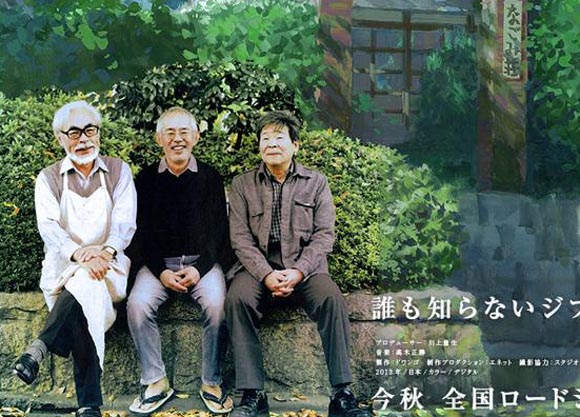 As reported by Anime News Network, documentary filmmaker Mami Sunada (Ending Note: Death of a Japanese Salaryman) is nearing completion on the Studio Ghibli documentary Kingdom of Dreams and Madness. The film follows studio producer Toshio Suzuki, and directors Hayao Miyazaki and Isao Takahata (Grave of the Fireflies) as they work on two upcoming Studio Ghibli films, Kaze Tachinu (The Wind Rises) and Kaguya-hime no Monogatori (The Tale of Princess Kaguya).
As reported by Anime News Network, documentary filmmaker Mami Sunada (Ending Note: Death of a Japanese Salaryman) is nearing completion on the Studio Ghibli documentary Kingdom of Dreams and Madness. The film follows studio producer Toshio Suzuki, and directors Hayao Miyazaki and Isao Takahata (Grave of the Fireflies) as they work on two upcoming Studio Ghibli films, Kaze Tachinu (The Wind Rises) and Kaguya-hime no Monogatori (The Tale of Princess Kaguya).
When discussing her film’s title, Sunada explains: “I think that having a dream entails having a bit of madness, no matter what the profession. There are times when you will go to extremes, and times when you are feared by others for that.”
The Wind Rises, which is the first Miyazaki directed film in five years, debuts this weekend in Japan. Centering on Zero fighter designer Jiro Horikoshi, it is inspired by a manga Miyazaki created for Gekkan Model Graphics magazine and based on the novel of the same name by Tatsuo Hori. The Tale of Princess Kaguya, directed by Takahata is an adaptation of the Japanese folk story, The Tale of the Bamboo Cutter. Originally slated to premiere simultaneously with The Wind Rises, Kaguya’s release date was postponed due to production snags, and as a result, Sunada continues to film in the studio to cover the extended production. Sunada’s documentary will premiere this fall in Japan.
Add a Comment
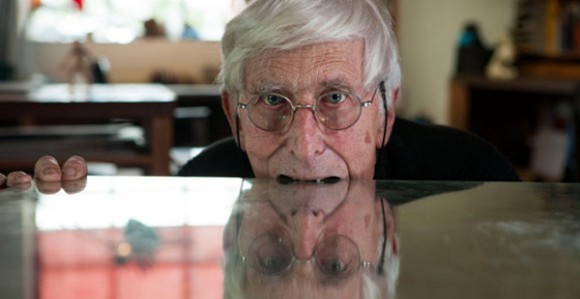 In the 1950s, when the pages of the Saturday Evening Post and McCall’s were dominated with the realist paintings of Norman Rockwell and Bernie Fuchs, French-born illustrator Tomi Ungerer brought in his loose, graphic drawing style and absurdist sensibilities and changed the direction of American illustration. In the new documentary film Far Out Isn’t Far Enough: The Tomi Ungerer Story, we learn about Ungerer’s early life in Alsace, France as a young artist encouraged by the Nazi party during their French occupation, to his journey to America in search of new opportunities, and his subsequent blacklisting from the children’s book industry.
In the 1950s, when the pages of the Saturday Evening Post and McCall’s were dominated with the realist paintings of Norman Rockwell and Bernie Fuchs, French-born illustrator Tomi Ungerer brought in his loose, graphic drawing style and absurdist sensibilities and changed the direction of American illustration. In the new documentary film Far Out Isn’t Far Enough: The Tomi Ungerer Story, we learn about Ungerer’s early life in Alsace, France as a young artist encouraged by the Nazi party during their French occupation, to his journey to America in search of new opportunities, and his subsequent blacklisting from the children’s book industry.
Featuring interviews with Steven Heller, Jules Feiffer and the late Maurice Sendak, Far Out Isn’t Far Enough is a buoyant and vivid documentary film, painting an inspiring picture of an award-winning illustrator, trilingual author, brilliant satirist, and dedicated humanitarian advocate. Ungerer upended social and professional morays in the pre-pre-Internet era, delighting (and offending) editors, critics and readers by breaking taboos, back when there was still a better assortment of taboos waiting to be broken.
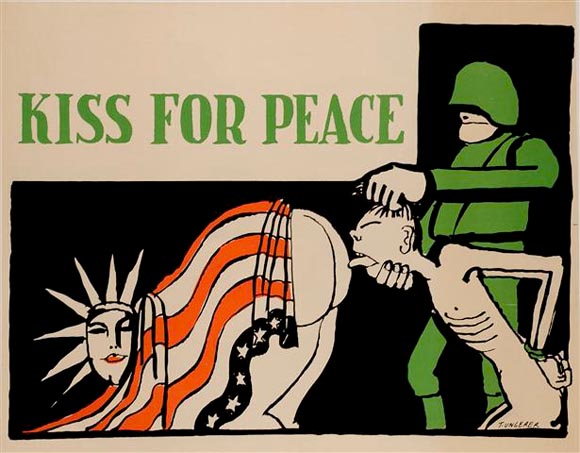 Ungerer’s portrayal is both of an unstable-but-good spirited neighborhood kook and avuncular storyteller, grinning from behind a freshly lit joint and admiring a recently found dismembered baby doll appendage. “Children should be traumatized,” he grins. “If you want to give them an identity, children should be traumatized.” And he speaks from personal experience; socially paranoid, emotionally erratic and “oblivious,” as recounted by Sendak, he represents that classic tortured artist, except that instead of wringing his hands over how best to suffer for his creations, he suffered, survived and then created.
Ungerer’s portrayal is both of an unstable-but-good spirited neighborhood kook and avuncular storyteller, grinning from behind a freshly lit joint and admiring a recently found dismembered baby doll appendage. “Children should be traumatized,” he grins. “If you want to give them an identity, children should be traumatized.” And he speaks from personal experience; socially paranoid, emotionally erratic and “oblivious,” as recounted by Sendak, he represents that classic tortured artist, except that instead of wringing his hands over how best to suffer for his creations, he suffered, survived and then created.
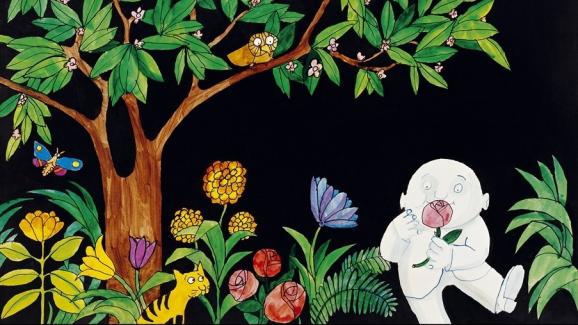 “When I draw it’s a real need,” says Ungerer. “It’s the kind of need like, if you’re hungry, you have to eat, or you have to go to the toilet—it’s got to go out.” His early children’s books, The Mellops Go Flying and Crictor, about pigs and a boa constrictor, respectively, set the tone for the work that would follow: “detestable” creatures (a vulture, a bat, an ogre) cleverly depicted as unlikely heroes, providing children with much needed provocative subject matter.
“When I draw it’s a real need,” says Ungerer. “It’s the kind of need like, if you’re hungry, you have to eat, or you have to go to the toilet—it’s got to go out.” His early children’s books, The Mellops Go Flying and Crictor, about pigs and a boa constrictor, respectively, set the tone for the work that would follow: “detestable” creatures (a vulture, a bat, an ogre) cleverly depicted as unlikely heroes, providing children with much needed provocative subject matter.
His political posters were motivated by his fascination with the American civil rights movement and the global conflicts of the 1960s: Uncle Sam shoving Lady Liberty down the throat of a Vietnamese man, a black figure and a white figure devouring each other from opposite ends, a military plane dropping silhouetted bombs under a curtain of pink ribbon presents with the label “Give,” all of which retain their graphic resonance to this day.
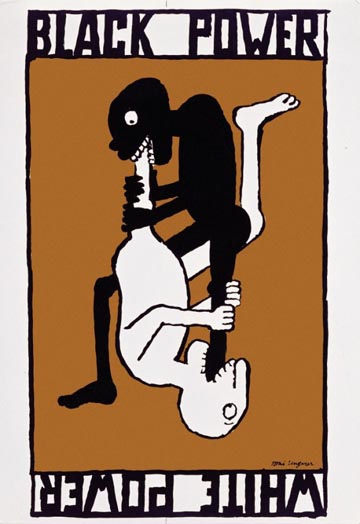
And his erotic works, which served as a personal rebellion against his puritanical upbringing, began with a personal relationship that involved “a bit of bondage,” and evolved into titles like Fornicon, a collection of erotica and “mechanical sex recipes.”
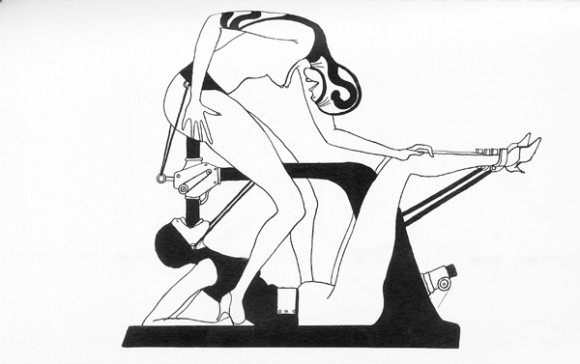 While the diversity of his work is one of the most unique aspects of his career, it was this sort of simultaneous co-habitation of creative worlds that eventually worked against him, getting his children’s books (unofficially) banned from libraries for over twenty-five years. His detractors have finally come around and he has received recognition for his body of work as a children’s book author and illustrator. In 1998, Ungerer was presented the Hans Christian Anderson award for his “lasting contribution to children’s literature” and named Ambassador for Childhood and Education by the 47-nation Council of Europe.
While the diversity of his work is one of the most unique aspects of his career, it was this sort of simultaneous co-habitation of creative worlds that eventually worked against him, getting his children’s books (unofficially) banned from libraries for over twenty-five years. His detractors have finally come around and he has received recognition for his body of work as a children’s book author and illustrator. In 1998, Ungerer was presented the Hans Christian Anderson award for his “lasting contribution to children’s literature” and named Ambassador for Childhood and Education by the 47-nation Council of Europe.
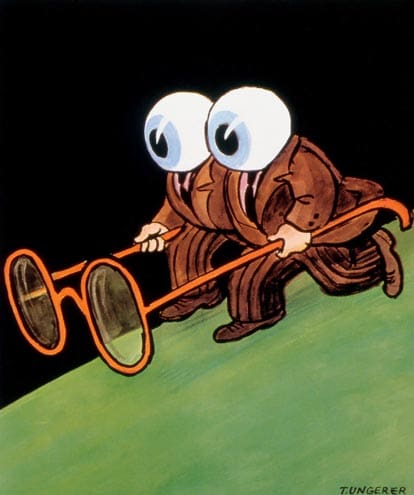
If anything, the film may leave you longing for the Golden Age of Publishing in the 1950s and ’60s, where any talented newcomer with the right portfolio—or in Ungerer’s case, a Trojan condom box—could go from door to door peddling their illustrations, and become an industry darling.
Far Out Isn’t Far Enough is directed by Brad Bernstein, and features motion graphics supervised by Brandon Dumlao. The film is distributed by First Run Features and is continuing to open in theaters across the country.
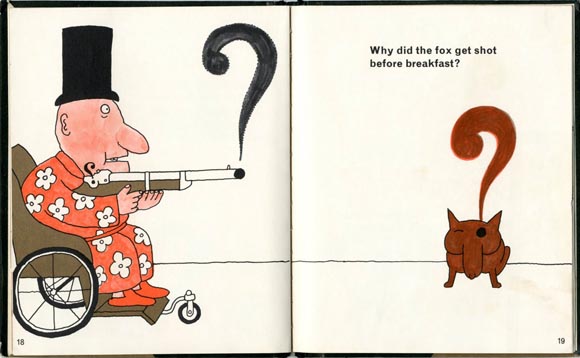

Cattle Call (2008) offers a fascinating glimpse into a world that is completely foreign to me. It made a strong impression when I saw it a few years back in Ottawa and I’m delighted to report that it’s every bit as exhilarating to watch again now that it’s been posted online.
Directed by Matt Rankin and Mike Maryniuk, the film uncovers the inherent art within livestock auctioneering, which filmmaker Werner Herzog once described as “the last poetry possible, the poetry of capitalism.”
Filmmakers Rankin and Maryniuk capture the madcap energy of their subject matter by deploying a rapid-fire assortment of techniques, including stop-motion, cut-outs, open-exposures, hole-punching and rubbing Letraset directly on the celluloid. They manage to turn this experimental grabbag into a mightily entertaining film—a testament to their skills as animation filmmakers. Their unconventional approach also shows that the documentary format in animation offers a range of nonliteral and non-narrative possibilities that extends beyond the formal limitations of live-action documentary.
Add a Comment

“It’s the way the world works. Essentially, poverty is what makes the rich rich.”
Poor Us: An Animated History of Poverty is a new documentary by Ben Lewis, debuting this week throughout Europe, and on PBS in the United States. The special, will be shown on TV in over 70 countries, is an animated survey of over 10,000 years of poverty. It draws on interviews with economists and historians including Jeffrey Sachs (author, The End of Poverty), Nobel laureate Joseph Stiglitz, Esther Duflo (MIT Poverty Lab and author, Poor Economics), Tim Hitchcock (Council of the Royal Historical Society), Emmanuel Akyeampong (Historian of Africa, Harvard) and Oscar Guardiola (Author, What if Latin America Ruled The World).
The animation portions of the film were directed by Fons Schiedon, designed by Cesare Davolio and Maarten Janssens, and animated by São Paulo, Brazil-based Birdo.
The director discusses the film at length on his website. American viewers can watch the entire film on the PBS website. Otherwise, here’s the trailer:
(Thanks, Fraser MacLean)
Add a Comment
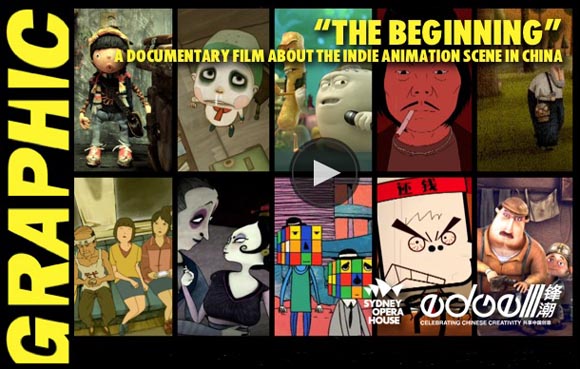
There’s a strong wave of indie animators emerging from Asian countries like Japan, South Korea, and China. The latter country’s indie scene is the focus of the documentary The Beginning directed by Jess Zou of NeochaEDGE. The film, which debuts in NY next week at the China Institute (125 East 65th Street, NY, NY 10065), features profiles of twenty Chinese animators and studios who are pursuing a more independent approach in their work. The 100-minute film is in Mandarin with English subtitles. Tickets are $8 and pre-registration is required on the Institute’s website.
Artists and studios featured in The Beginning include: Ray Lei (Beijing), Sun Haipeng (Shenzhen), Liu Jian (Nanjing), Mao Qichao (Magic Animation Studio, Chengdu), Pi San (Beijing), Anytime (aka: ANI7IME) Animation Studio (Zhang Chunli, Pu Junhan, Li Weikun, Su Jingxin: Guangzhou), Seen Studio (Zhang Naowen, Aspirin, Zeng Xun: Beijing), Song Siqi (Henan)/Wang Qing (Suzhou), Li Dongzhen (Beijing), and Beijing Film Academy student animation group (Sun Yiran, Wang Xingchen, Chen Xi, Zhang Yi, and Zhang Xiadian).
